UWL Research Ethics and Data Management for Secondary Data Collection
VerifiedAdded on 2022/11/24
|13
|2268
|255
Homework Assignment
AI Summary
This document is a research ethics application form completed by a student at the University of West London (UWL) for a project involving secondary data collection. The application includes sections for ethics assessment, data management, and project details. The student confirms that the research will not involve human participants directly, focusing instead on analyzing existing secondary data sources. The project aims to systematically analyze qualitative information to understand human resource management practices, specifically within British Airways. The application outlines the research design, methodology, and data analysis techniques, including a qualitative approach using thematic analysis. The document also includes a data management and storage statement, adhering to data protection principles and ensuring the security and confidentiality of the data. The student acknowledges their responsibility for data security and outlines measures for anonymization, secure storage, and disposal of data. The student also provides references to relevant literature.
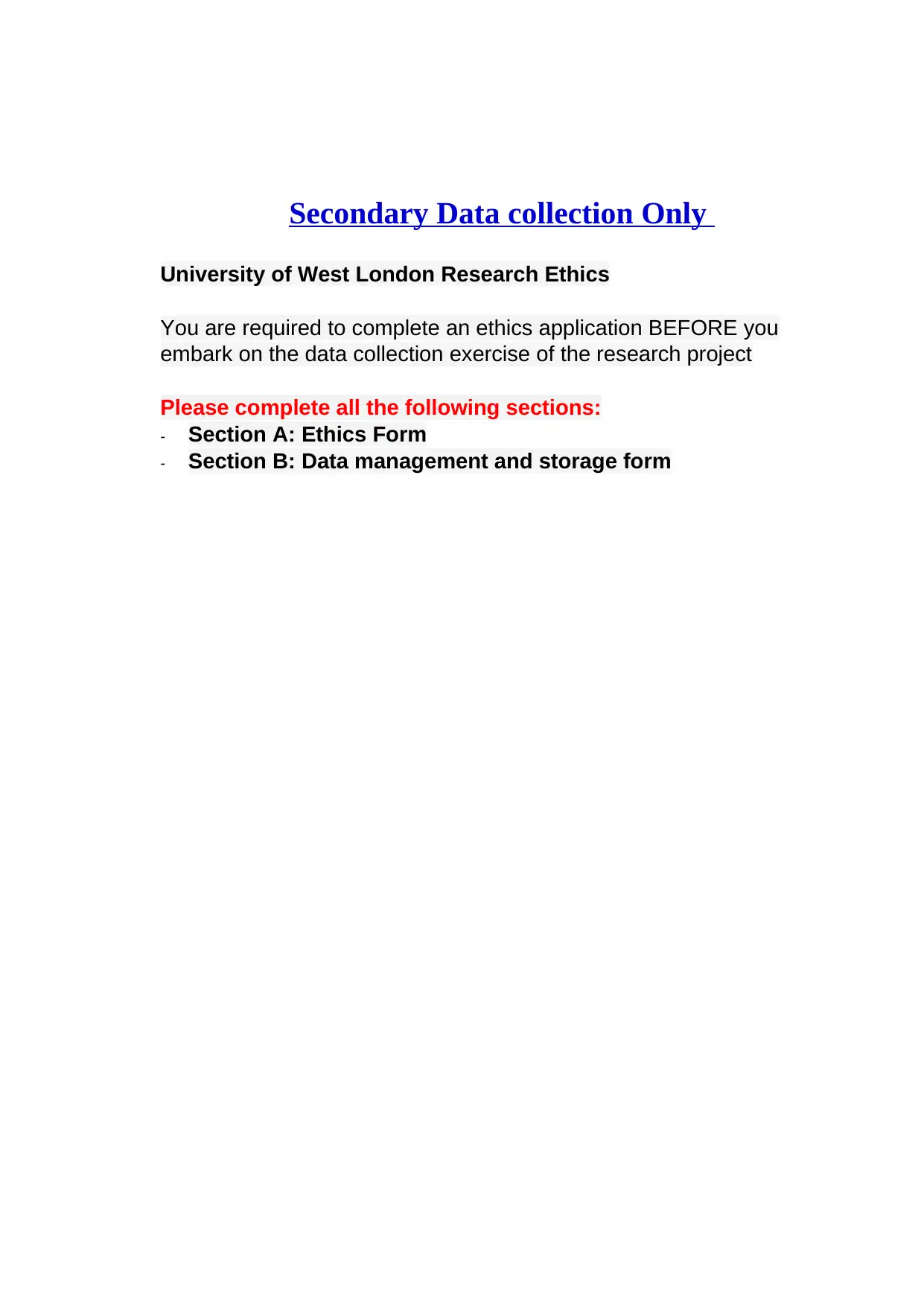
Secondary Data collection Only
University of West London Research Ethics
You are required to complete an ethics application BEFORE you
embark on the data collection exercise of the research project
Please complete all the following sections:
- Section A: Ethics Form
- Section B: Data management and storage form
University of West London Research Ethics
You are required to complete an ethics application BEFORE you
embark on the data collection exercise of the research project
Please complete all the following sections:
- Section A: Ethics Form
- Section B: Data management and storage form
Paraphrase This Document
Need a fresh take? Get an instant paraphrase of this document with our AI Paraphraser
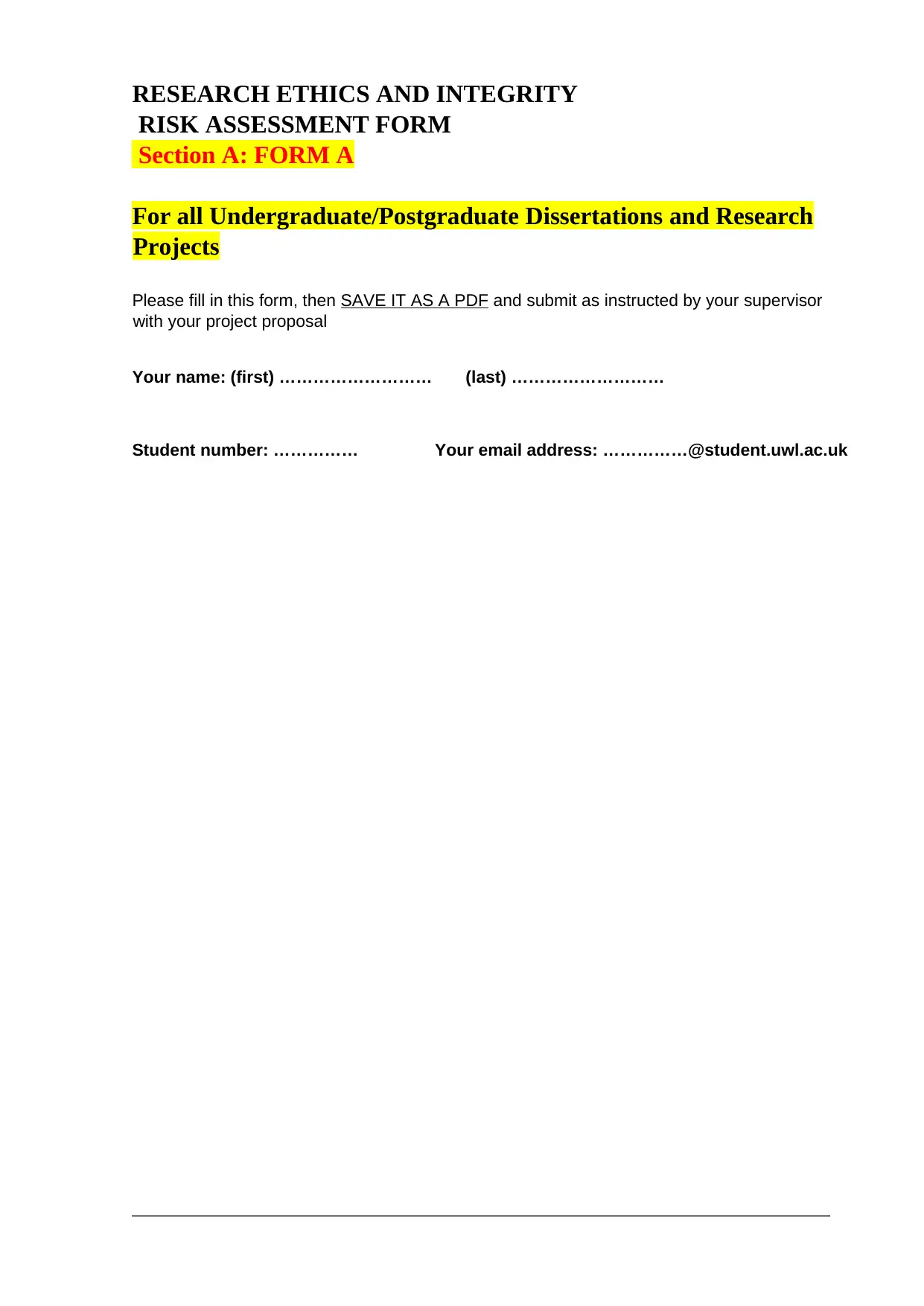
RESEARCH ETHICS AND INTEGRITY
RISK ASSESSMENT FORM
Section A: FORM A
For all Undergraduate/Postgraduate Dissertations and Research
Projects
Please fill in this form, then SAVE IT AS A PDF and submit as instructed by your supervisor
with your project proposal
Your name: (first) ……………………… (last) ………………………
Student number: …………… Your email address: ……………@student.uwl.ac.uk
RISK ASSESSMENT FORM
Section A: FORM A
For all Undergraduate/Postgraduate Dissertations and Research
Projects
Please fill in this form, then SAVE IT AS A PDF and submit as instructed by your supervisor
with your project proposal
Your name: (first) ……………………… (last) ………………………
Student number: …………… Your email address: ……………@student.uwl.ac.uk
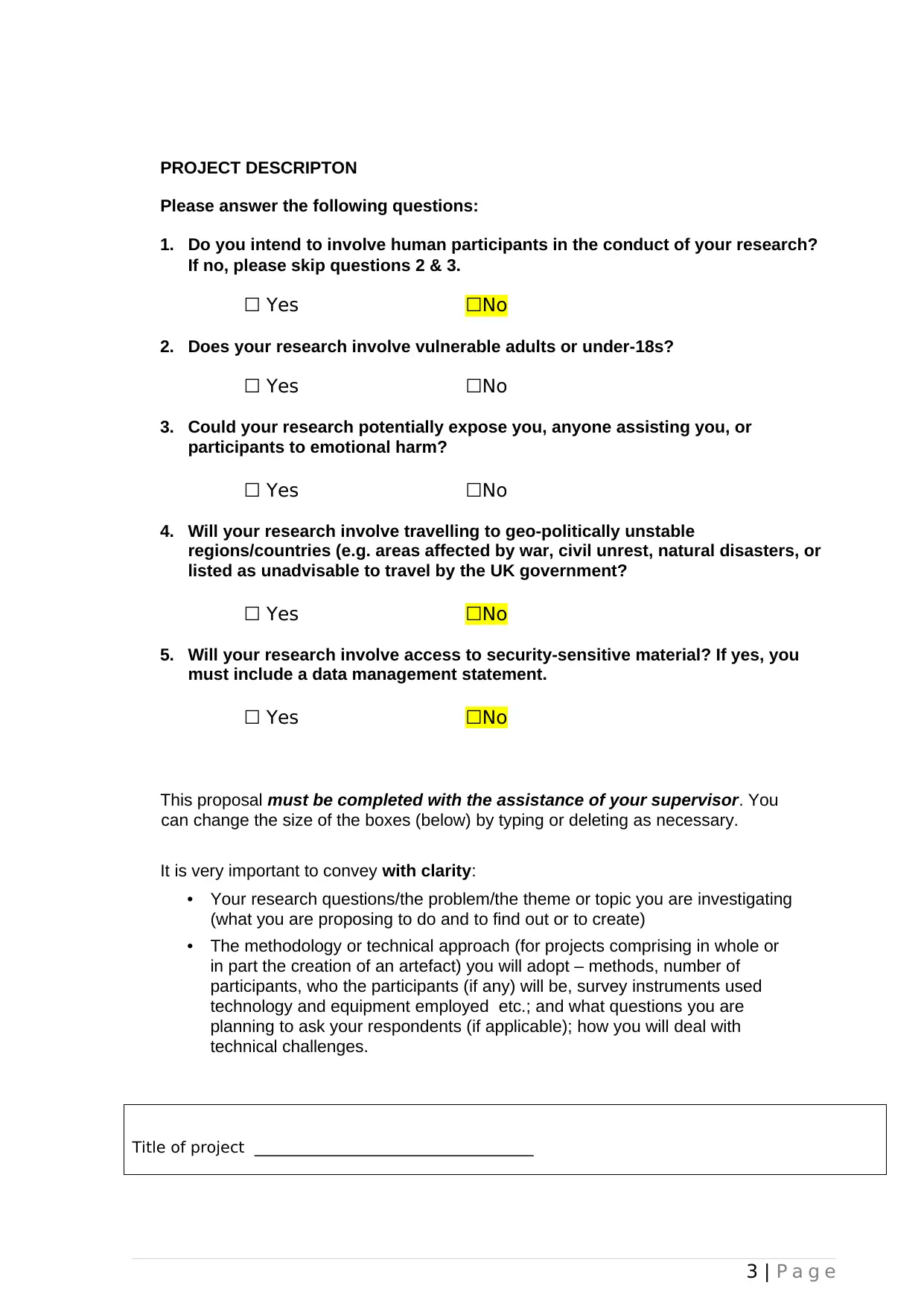
PROJECT DESCRIPTON
Please answer the following questions:
1. Do you intend to involve human participants in the conduct of your research?
If no, please skip questions 2 & 3.
☐ Yes ☐No
2. Does your research involve vulnerable adults or under-18s?
☐ Yes ☐No
3. Could your research potentially expose you, anyone assisting you, or
participants to emotional harm?
☐ Yes ☐No
4. Will your research involve travelling to geo-politically unstable
regions/countries (e.g. areas affected by war, civil unrest, natural disasters, or
listed as unadvisable to travel by the UK government?
☐ Yes ☐No
5. Will your research involve access to security-sensitive material? If yes, you
must include a data management statement.
☐ Yes ☐No
This proposal must be completed with the assistance of your supervisor. You
can change the size of the boxes (below) by typing or deleting as necessary.
It is very important to convey with clarity:
• Your research questions/the problem/the theme or topic you are investigating
(what you are proposing to do and to find out or to create)
• The methodology or technical approach (for projects comprising in whole or
in part the creation of an artefact) you will adopt – methods, number of
participants, who the participants (if any) will be, survey instruments used
technology and equipment employed etc.; and what questions you are
planning to ask your respondents (if applicable); how you will deal with
technical challenges.
Title of project ____________________________________
3 | P a g e
Please answer the following questions:
1. Do you intend to involve human participants in the conduct of your research?
If no, please skip questions 2 & 3.
☐ Yes ☐No
2. Does your research involve vulnerable adults or under-18s?
☐ Yes ☐No
3. Could your research potentially expose you, anyone assisting you, or
participants to emotional harm?
☐ Yes ☐No
4. Will your research involve travelling to geo-politically unstable
regions/countries (e.g. areas affected by war, civil unrest, natural disasters, or
listed as unadvisable to travel by the UK government?
☐ Yes ☐No
5. Will your research involve access to security-sensitive material? If yes, you
must include a data management statement.
☐ Yes ☐No
This proposal must be completed with the assistance of your supervisor. You
can change the size of the boxes (below) by typing or deleting as necessary.
It is very important to convey with clarity:
• Your research questions/the problem/the theme or topic you are investigating
(what you are proposing to do and to find out or to create)
• The methodology or technical approach (for projects comprising in whole or
in part the creation of an artefact) you will adopt – methods, number of
participants, who the participants (if any) will be, survey instruments used
technology and equipment employed etc.; and what questions you are
planning to ask your respondents (if applicable); how you will deal with
technical challenges.
Title of project ____________________________________
3 | P a g e
⊘ This is a preview!⊘
Do you want full access?
Subscribe today to unlock all pages.

Trusted by 1+ million students worldwide
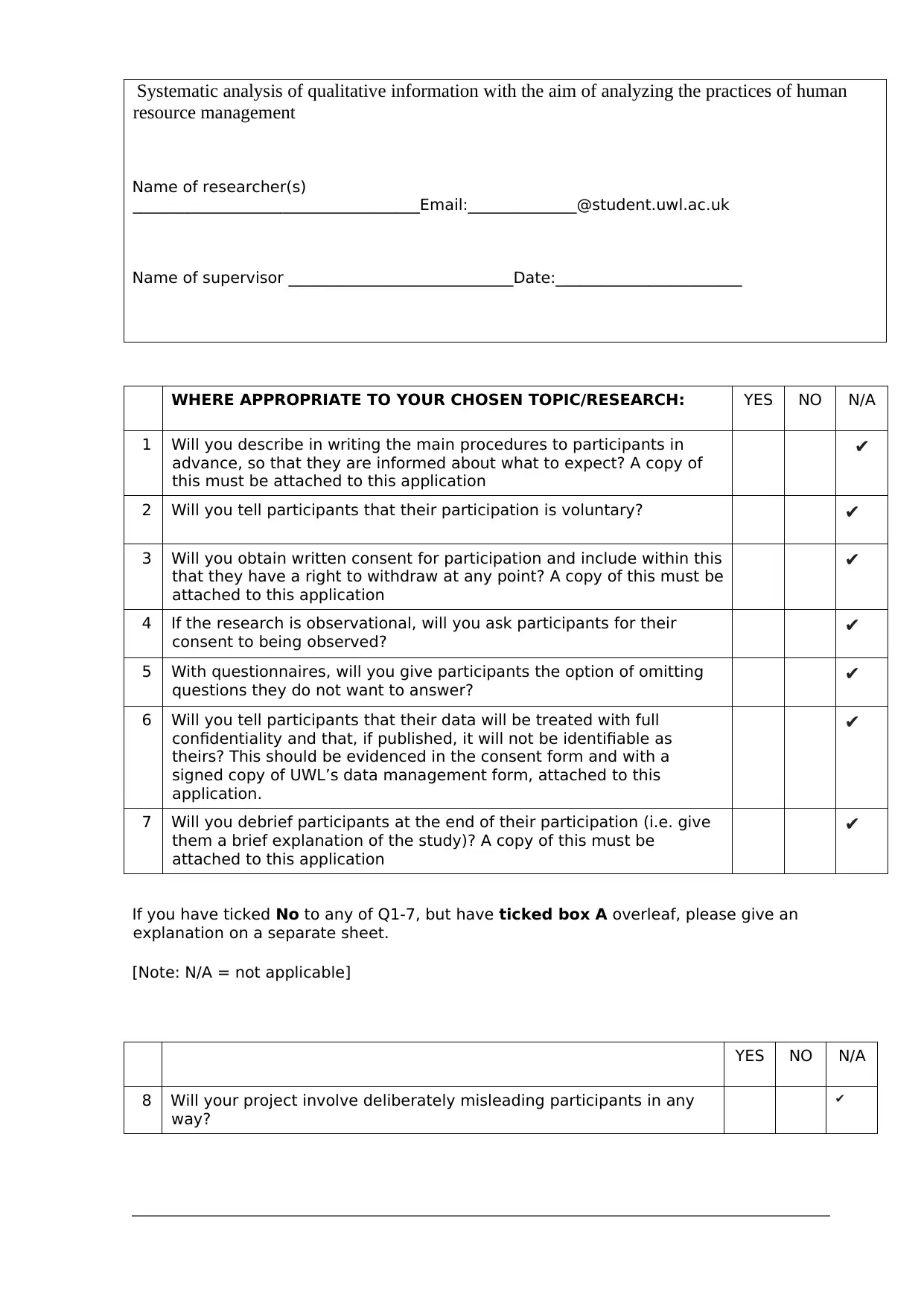
Systematic analysis of qualitative information with the aim of analyzing the practices of human
resource management
Name of researcher(s)
_____________________________________Email:______________@student.uwl.ac.uk
Name of supervisor _____________________________Date:________________________
WHERE APPROPRIATE TO YOUR CHOSEN TOPIC/RESEARCH: YES NO N/A
1 Will you describe in writing the main procedures to participants in
advance, so that they are informed about what to expect? A copy of
this must be attached to this application
✔
2 Will you tell participants that their participation is voluntary? ✔
3 Will you obtain written consent for participation and include within this
that they have a right to withdraw at any point? A copy of this must be
attached to this application
✔
4 If the research is observational, will you ask participants for their
consent to being observed? ✔
5 With questionnaires, will you give participants the option of omitting
questions they do not want to answer? ✔
6 Will you tell participants that their data will be treated with full
confidentiality and that, if published, it will not be identifiable as
theirs? This should be evidenced in the consent form and with a
signed copy of UWL’s data management form, attached to this
application.
✔
7 Will you debrief participants at the end of their participation (i.e. give
them a brief explanation of the study)? A copy of this must be
attached to this application
✔
If you have ticked No to any of Q1-7, but have ticked box A overleaf, please give an
explanation on a separate sheet.
[Note: N/A = not applicable]
YES NO N/A
8 Will your project involve deliberately misleading participants in any
way?
✔
resource management
Name of researcher(s)
_____________________________________Email:______________@student.uwl.ac.uk
Name of supervisor _____________________________Date:________________________
WHERE APPROPRIATE TO YOUR CHOSEN TOPIC/RESEARCH: YES NO N/A
1 Will you describe in writing the main procedures to participants in
advance, so that they are informed about what to expect? A copy of
this must be attached to this application
✔
2 Will you tell participants that their participation is voluntary? ✔
3 Will you obtain written consent for participation and include within this
that they have a right to withdraw at any point? A copy of this must be
attached to this application
✔
4 If the research is observational, will you ask participants for their
consent to being observed? ✔
5 With questionnaires, will you give participants the option of omitting
questions they do not want to answer? ✔
6 Will you tell participants that their data will be treated with full
confidentiality and that, if published, it will not be identifiable as
theirs? This should be evidenced in the consent form and with a
signed copy of UWL’s data management form, attached to this
application.
✔
7 Will you debrief participants at the end of their participation (i.e. give
them a brief explanation of the study)? A copy of this must be
attached to this application
✔
If you have ticked No to any of Q1-7, but have ticked box A overleaf, please give an
explanation on a separate sheet.
[Note: N/A = not applicable]
YES NO N/A
8 Will your project involve deliberately misleading participants in any
way?
✔
Paraphrase This Document
Need a fresh take? Get an instant paraphrase of this document with our AI Paraphraser

9 Is there any realistic risk of any participants experiencing either
physical or psychological distress or discomfort? If Yes, give details
on a separate sheet and state what you will tell them to do if they
should experience any problems (e.g. who they can contact for help).
✔
If you have ticked Yes to 8 or 9, you should normally tick box B overleaf; if not, please
give a full explanation on a separate sheet
YES NO N/A
10 Does your project involve work with animals? If yes, please tick
box B overleaf.
✔
11 Do participants fall into any of
the following vulnerable
groups? If they do, please and
tick box B overleaf.
Note that you may also need
to obtain satisfactory DBS
clearance (or equivalent for
overseas students).
Schoolchildren (under 18 years of
age)
✔
People with learning or
communication difficulties
✔
Patients ✔
People in custody ✔
People engaged in illegal
activities (e.g. drug-taking)
✔
Any other groups who could be
reasonably argued as
representing any form of
vulnerability – please specify
✔
12 Will you be accessing materials which may be considered security-
sensitive under the Counter Terrorism Act (2015)? ✔
There is an obligation on the researcher to bring to the attention of the School Ethics Panel any
issues with ethical implications not clearly covered by the above checklist.
PLEASE TICK EITHER BOX A OR BOX B BELOW AND PROVIDE THE DETAILS REQUIRED
IN SUPPORT OF YOUR APPLICATION. THEN SIGN THE FORM.
Please tick
A. I consider that this project has no significant ethical implications to be brought
before the School Ethics Panel. ✔
B. I consider that this project may have ethical implications that should be brought
before the School Ethics Panel, and/or it will be carried out with children or other
vulnerable populations.
I have received guidance on ethical research practices relevant to my subject as part of
my preparation for this module.
5 | P a g e
physical or psychological distress or discomfort? If Yes, give details
on a separate sheet and state what you will tell them to do if they
should experience any problems (e.g. who they can contact for help).
✔
If you have ticked Yes to 8 or 9, you should normally tick box B overleaf; if not, please
give a full explanation on a separate sheet
YES NO N/A
10 Does your project involve work with animals? If yes, please tick
box B overleaf.
✔
11 Do participants fall into any of
the following vulnerable
groups? If they do, please and
tick box B overleaf.
Note that you may also need
to obtain satisfactory DBS
clearance (or equivalent for
overseas students).
Schoolchildren (under 18 years of
age)
✔
People with learning or
communication difficulties
✔
Patients ✔
People in custody ✔
People engaged in illegal
activities (e.g. drug-taking)
✔
Any other groups who could be
reasonably argued as
representing any form of
vulnerability – please specify
✔
12 Will you be accessing materials which may be considered security-
sensitive under the Counter Terrorism Act (2015)? ✔
There is an obligation on the researcher to bring to the attention of the School Ethics Panel any
issues with ethical implications not clearly covered by the above checklist.
PLEASE TICK EITHER BOX A OR BOX B BELOW AND PROVIDE THE DETAILS REQUIRED
IN SUPPORT OF YOUR APPLICATION. THEN SIGN THE FORM.
Please tick
A. I consider that this project has no significant ethical implications to be brought
before the School Ethics Panel. ✔
B. I consider that this project may have ethical implications that should be brought
before the School Ethics Panel, and/or it will be carried out with children or other
vulnerable populations.
I have received guidance on ethical research practices relevant to my subject as part of
my preparation for this module.
5 | P a g e

Signed ___________________________ Print Name ______________________ Date
_______________
(UG Researcher(s))
Signed ___________________________ Print Name ______________________ Date
_______________
(Supervisor)
_______________
(UG Researcher(s))
Signed ___________________________ Print Name ______________________ Date
_______________
(Supervisor)
⊘ This is a preview!⊘
Do you want full access?
Subscribe today to unlock all pages.

Trusted by 1+ million students worldwide
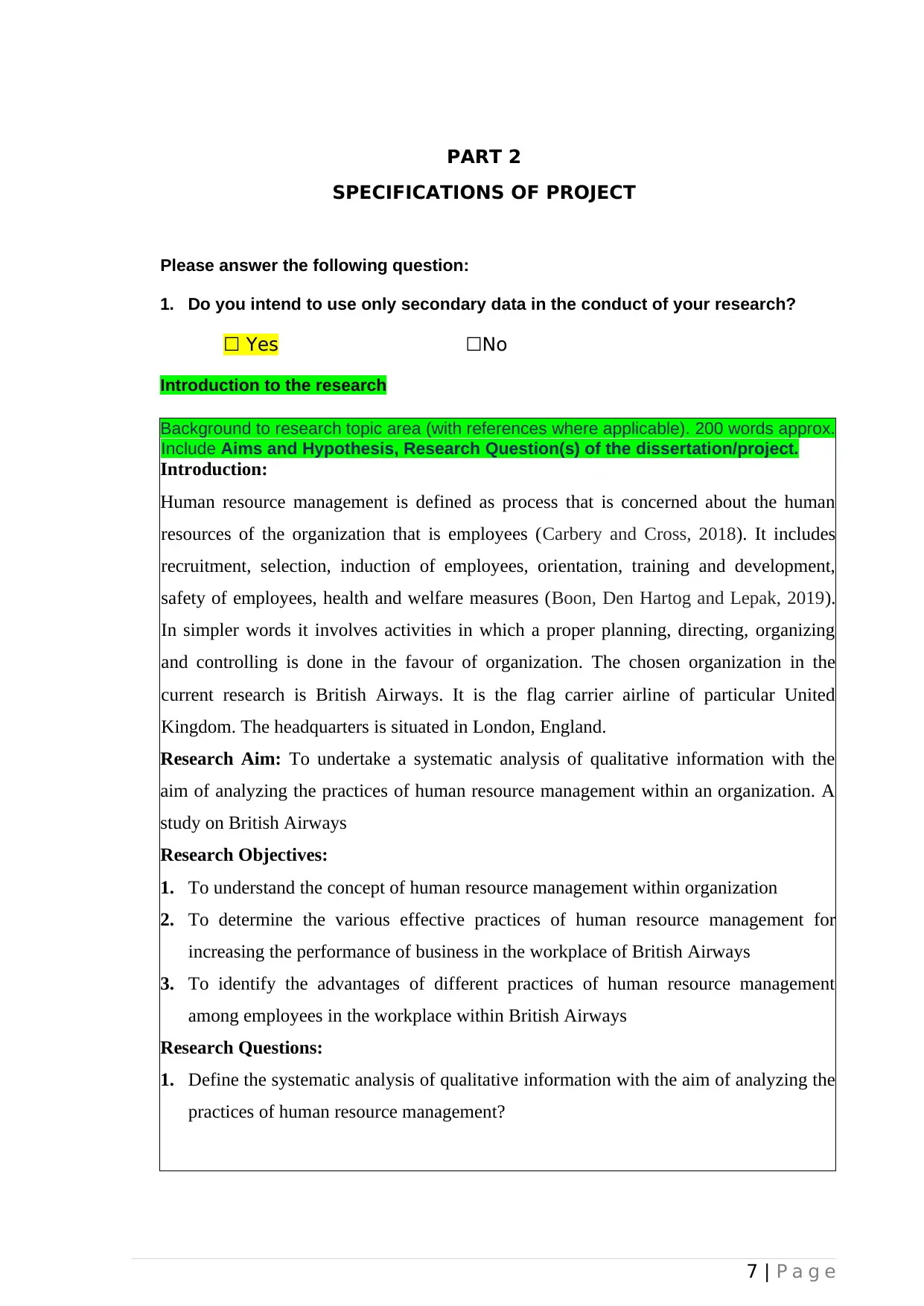
PART 2
SPECIFICATIONS OF PROJECT
Please answer the following question:
1. Do you intend to use only secondary data in the conduct of your research?
☐ Yes ☐No
Introduction to the research
Background to research topic area (with references where applicable). 200 words approx.
Include Aims and Hypothesis, Research Question(s) of the dissertation/project.
Introduction:
Human resource management is defined as process that is concerned about the human
resources of the organization that is employees (Carbery and Cross, 2018). It includes
recruitment, selection, induction of employees, orientation, training and development,
safety of employees, health and welfare measures (Boon, Den Hartog and Lepak, 2019).
In simpler words it involves activities in which a proper planning, directing, organizing
and controlling is done in the favour of organization. The chosen organization in the
current research is British Airways. It is the flag carrier airline of particular United
Kingdom. The headquarters is situated in London, England.
Research Aim: To undertake a systematic analysis of qualitative information with the
aim of analyzing the practices of human resource management within an organization. A
study on British Airways
Research Objectives:
1. To understand the concept of human resource management within organization
2. To determine the various effective practices of human resource management for
increasing the performance of business in the workplace of British Airways
3. To identify the advantages of different practices of human resource management
among employees in the workplace within British Airways
Research Questions:
1. Define the systematic analysis of qualitative information with the aim of analyzing the
practices of human resource management?
7 | P a g e
SPECIFICATIONS OF PROJECT
Please answer the following question:
1. Do you intend to use only secondary data in the conduct of your research?
☐ Yes ☐No
Introduction to the research
Background to research topic area (with references where applicable). 200 words approx.
Include Aims and Hypothesis, Research Question(s) of the dissertation/project.
Introduction:
Human resource management is defined as process that is concerned about the human
resources of the organization that is employees (Carbery and Cross, 2018). It includes
recruitment, selection, induction of employees, orientation, training and development,
safety of employees, health and welfare measures (Boon, Den Hartog and Lepak, 2019).
In simpler words it involves activities in which a proper planning, directing, organizing
and controlling is done in the favour of organization. The chosen organization in the
current research is British Airways. It is the flag carrier airline of particular United
Kingdom. The headquarters is situated in London, England.
Research Aim: To undertake a systematic analysis of qualitative information with the
aim of analyzing the practices of human resource management within an organization. A
study on British Airways
Research Objectives:
1. To understand the concept of human resource management within organization
2. To determine the various effective practices of human resource management for
increasing the performance of business in the workplace of British Airways
3. To identify the advantages of different practices of human resource management
among employees in the workplace within British Airways
Research Questions:
1. Define the systematic analysis of qualitative information with the aim of analyzing the
practices of human resource management?
7 | P a g e
Paraphrase This Document
Need a fresh take? Get an instant paraphrase of this document with our AI Paraphraser
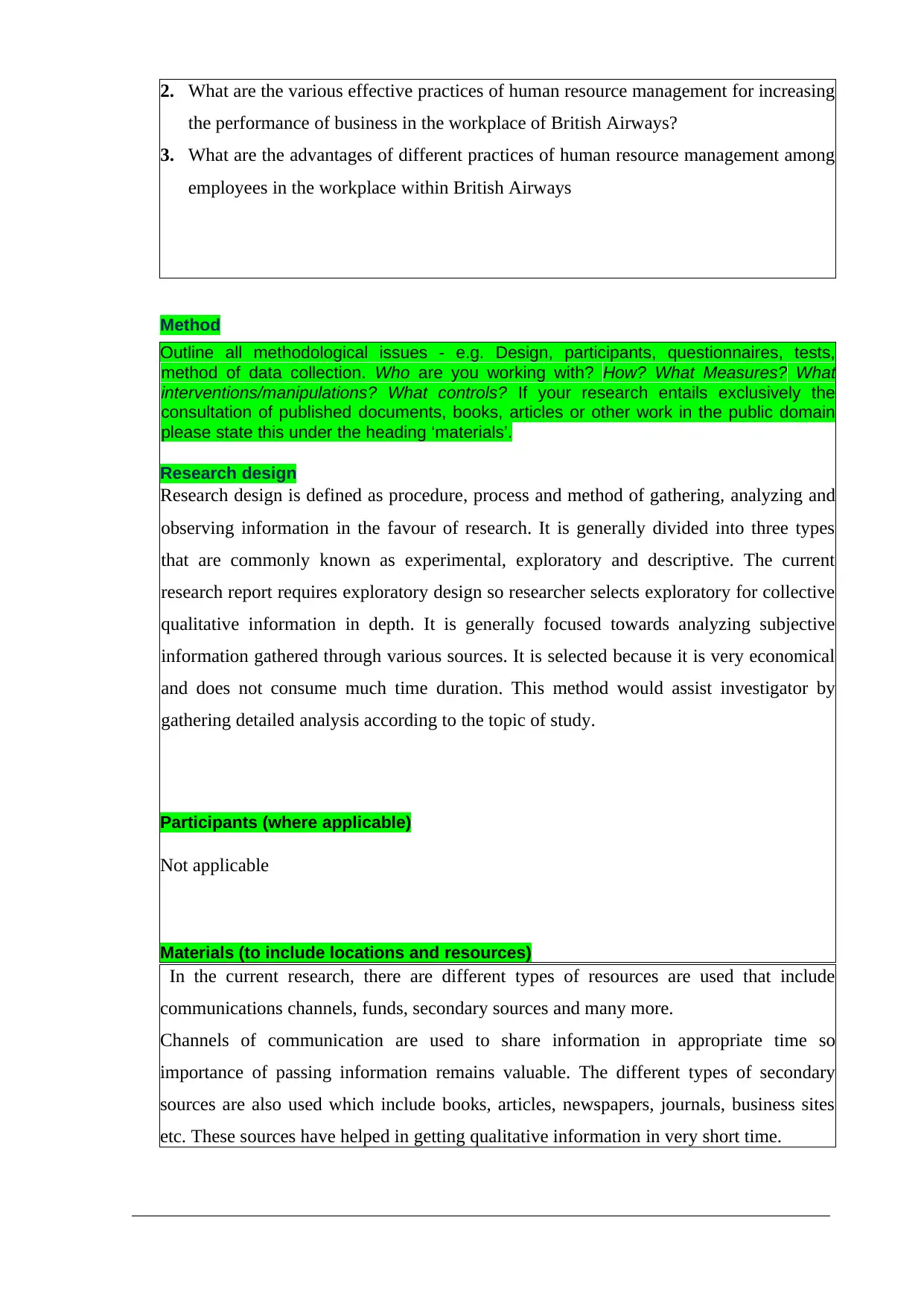
2. What are the various effective practices of human resource management for increasing
the performance of business in the workplace of British Airways?
3. What are the advantages of different practices of human resource management among
employees in the workplace within British Airways
Method
Outline all methodological issues - e.g. Design, participants, questionnaires, tests,
method of data collection. Who are you working with? How? What Measures? What
interventions/manipulations? What controls? If your research entails exclusively the
consultation of published documents, books, articles or other work in the public domain
please state this under the heading ‘materials’.
Research design
Research design is defined as procedure, process and method of gathering, analyzing and
observing information in the favour of research. It is generally divided into three types
that are commonly known as experimental, exploratory and descriptive. The current
research report requires exploratory design so researcher selects exploratory for collective
qualitative information in depth. It is generally focused towards analyzing subjective
information gathered through various sources. It is selected because it is very economical
and does not consume much time duration. This method would assist investigator by
gathering detailed analysis according to the topic of study.
Participants (where applicable)
Not applicable
Materials (to include locations and resources)
In the current research, there are different types of resources are used that include
communications channels, funds, secondary sources and many more.
Channels of communication are used to share information in appropriate time so
importance of passing information remains valuable. The different types of secondary
sources are also used which include books, articles, newspapers, journals, business sites
etc. These sources have helped in getting qualitative information in very short time.
the performance of business in the workplace of British Airways?
3. What are the advantages of different practices of human resource management among
employees in the workplace within British Airways
Method
Outline all methodological issues - e.g. Design, participants, questionnaires, tests,
method of data collection. Who are you working with? How? What Measures? What
interventions/manipulations? What controls? If your research entails exclusively the
consultation of published documents, books, articles or other work in the public domain
please state this under the heading ‘materials’.
Research design
Research design is defined as procedure, process and method of gathering, analyzing and
observing information in the favour of research. It is generally divided into three types
that are commonly known as experimental, exploratory and descriptive. The current
research report requires exploratory design so researcher selects exploratory for collective
qualitative information in depth. It is generally focused towards analyzing subjective
information gathered through various sources. It is selected because it is very economical
and does not consume much time duration. This method would assist investigator by
gathering detailed analysis according to the topic of study.
Participants (where applicable)
Not applicable
Materials (to include locations and resources)
In the current research, there are different types of resources are used that include
communications channels, funds, secondary sources and many more.
Channels of communication are used to share information in appropriate time so
importance of passing information remains valuable. The different types of secondary
sources are also used which include books, articles, newspapers, journals, business sites
etc. These sources have helped in getting qualitative information in very short time.
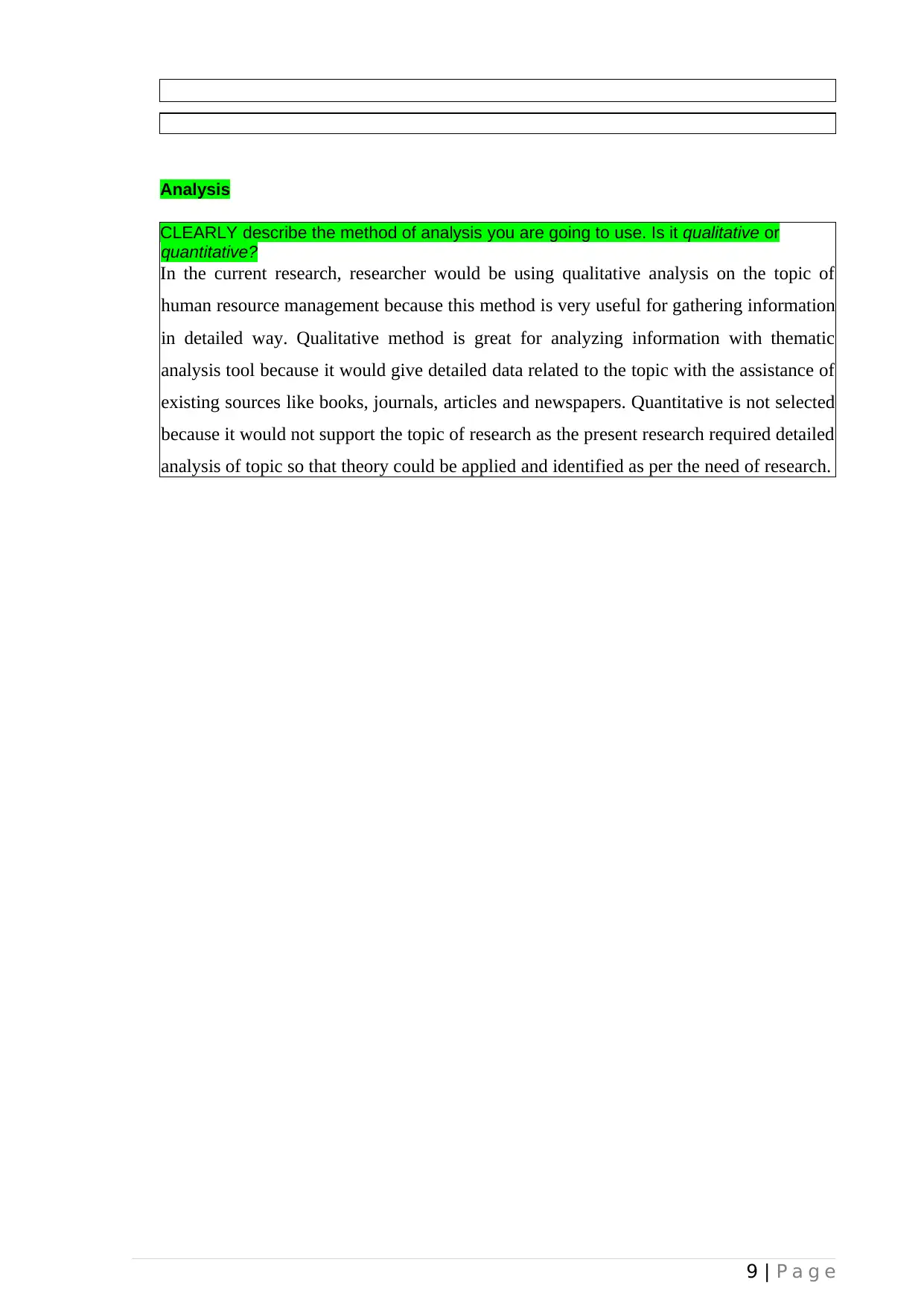
Analysis
CLEARLY describe the method of analysis you are going to use. Is it qualitative or
quantitative?
In the current research, researcher would be using qualitative analysis on the topic of
human resource management because this method is very useful for gathering information
in detailed way. Qualitative method is great for analyzing information with thematic
analysis tool because it would give detailed data related to the topic with the assistance of
existing sources like books, journals, articles and newspapers. Quantitative is not selected
because it would not support the topic of research as the present research required detailed
analysis of topic so that theory could be applied and identified as per the need of research.
9 | P a g e
CLEARLY describe the method of analysis you are going to use. Is it qualitative or
quantitative?
In the current research, researcher would be using qualitative analysis on the topic of
human resource management because this method is very useful for gathering information
in detailed way. Qualitative method is great for analyzing information with thematic
analysis tool because it would give detailed data related to the topic with the assistance of
existing sources like books, journals, articles and newspapers. Quantitative is not selected
because it would not support the topic of research as the present research required detailed
analysis of topic so that theory could be applied and identified as per the need of research.
9 | P a g e
⊘ This is a preview!⊘
Do you want full access?
Subscribe today to unlock all pages.

Trusted by 1+ million students worldwide
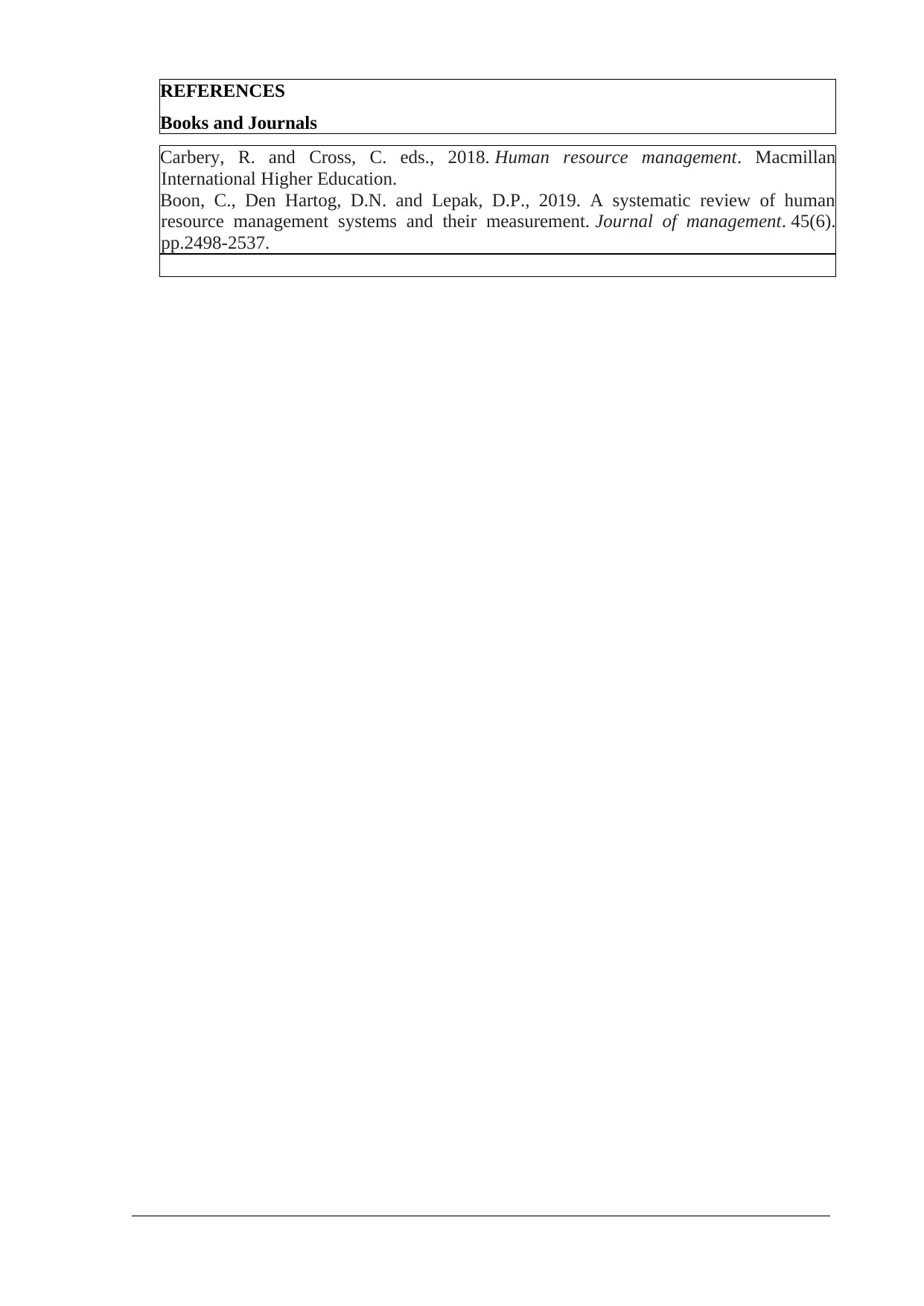
REFERENCES
Books and Journals
Carbery, R. and Cross, C. eds., 2018. Human resource management. Macmillan
International Higher Education.
Boon, C., Den Hartog, D.N. and Lepak, D.P., 2019. A systematic review of human
resource management systems and their measurement. Journal of management. 45(6).
pp.2498-2537.
Books and Journals
Carbery, R. and Cross, C. eds., 2018. Human resource management. Macmillan
International Higher Education.
Boon, C., Den Hartog, D.N. and Lepak, D.P., 2019. A systematic review of human
resource management systems and their measurement. Journal of management. 45(6).
pp.2498-2537.
Paraphrase This Document
Need a fresh take? Get an instant paraphrase of this document with our AI Paraphraser
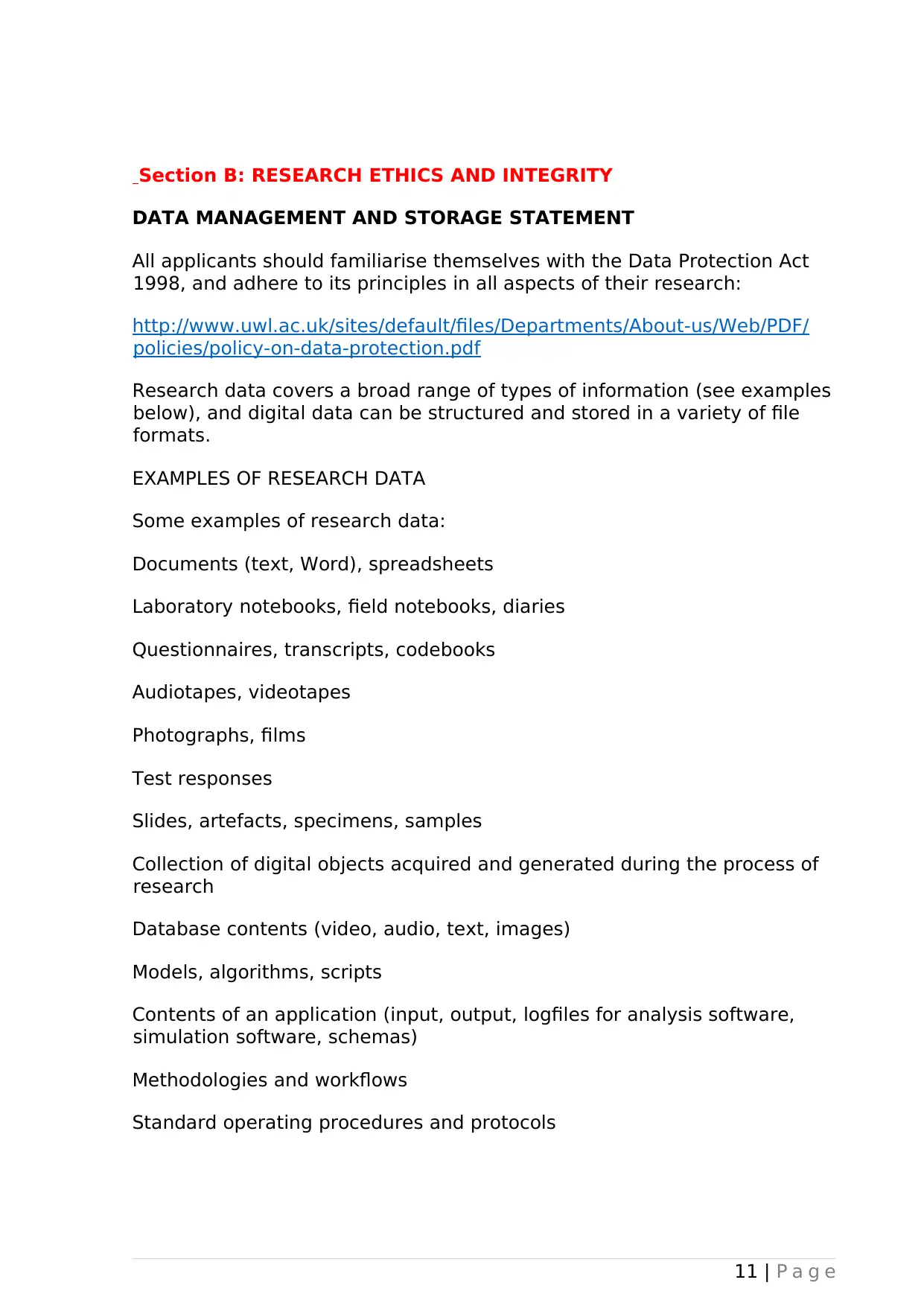
Section B: RESEARCH ETHICS AND INTEGRITY
DATA MANAGEMENT AND STORAGE STATEMENT
All applicants should familiarise themselves with the Data Protection Act
1998, and adhere to its principles in all aspects of their research:
http://www.uwl.ac.uk/sites/default/files/Departments/About-us/Web/PDF/
policies/policy-on-data-protection.pdf
Research data covers a broad range of types of information (see examples
below), and digital data can be structured and stored in a variety of file
formats.
EXAMPLES OF RESEARCH DATA
Some examples of research data:
Documents (text, Word), spreadsheets
Laboratory notebooks, field notebooks, diaries
Questionnaires, transcripts, codebooks
Audiotapes, videotapes
Photographs, films
Test responses
Slides, artefacts, specimens, samples
Collection of digital objects acquired and generated during the process of
research
Database contents (video, audio, text, images)
Models, algorithms, scripts
Contents of an application (input, output, logfiles for analysis software,
simulation software, schemas)
Methodologies and workflows
Standard operating procedures and protocols
11 | P a g e
DATA MANAGEMENT AND STORAGE STATEMENT
All applicants should familiarise themselves with the Data Protection Act
1998, and adhere to its principles in all aspects of their research:
http://www.uwl.ac.uk/sites/default/files/Departments/About-us/Web/PDF/
policies/policy-on-data-protection.pdf
Research data covers a broad range of types of information (see examples
below), and digital data can be structured and stored in a variety of file
formats.
EXAMPLES OF RESEARCH DATA
Some examples of research data:
Documents (text, Word), spreadsheets
Laboratory notebooks, field notebooks, diaries
Questionnaires, transcripts, codebooks
Audiotapes, videotapes
Photographs, films
Test responses
Slides, artefacts, specimens, samples
Collection of digital objects acquired and generated during the process of
research
Database contents (video, audio, text, images)
Models, algorithms, scripts
Contents of an application (input, output, logfiles for analysis software,
simulation software, schemas)
Methodologies and workflows
Standard operating procedures and protocols
11 | P a g e
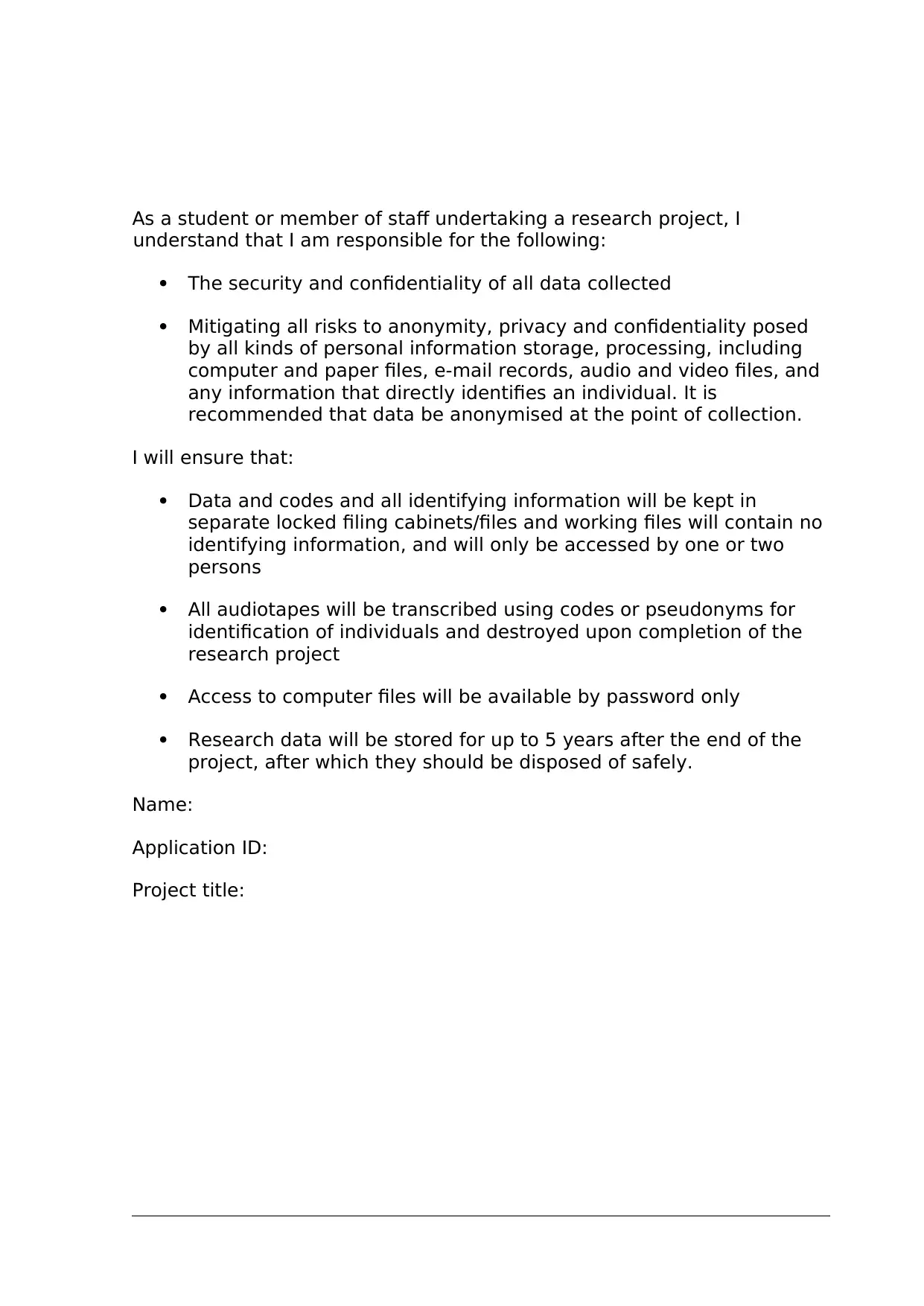
As a student or member of staff undertaking a research project, I
understand that I am responsible for the following:
The security and confidentiality of all data collected
Mitigating all risks to anonymity, privacy and confidentiality posed
by all kinds of personal information storage, processing, including
computer and paper files, e-mail records, audio and video files, and
any information that directly identifies an individual. It is
recommended that data be anonymised at the point of collection.
I will ensure that:
Data and codes and all identifying information will be kept in
separate locked filing cabinets/files and working files will contain no
identifying information, and will only be accessed by one or two
persons
All audiotapes will be transcribed using codes or pseudonyms for
identification of individuals and destroyed upon completion of the
research project
Access to computer files will be available by password only
Research data will be stored for up to 5 years after the end of the
project, after which they should be disposed of safely.
Name:
Application ID:
Project title:
understand that I am responsible for the following:
The security and confidentiality of all data collected
Mitigating all risks to anonymity, privacy and confidentiality posed
by all kinds of personal information storage, processing, including
computer and paper files, e-mail records, audio and video files, and
any information that directly identifies an individual. It is
recommended that data be anonymised at the point of collection.
I will ensure that:
Data and codes and all identifying information will be kept in
separate locked filing cabinets/files and working files will contain no
identifying information, and will only be accessed by one or two
persons
All audiotapes will be transcribed using codes or pseudonyms for
identification of individuals and destroyed upon completion of the
research project
Access to computer files will be available by password only
Research data will be stored for up to 5 years after the end of the
project, after which they should be disposed of safely.
Name:
Application ID:
Project title:
⊘ This is a preview!⊘
Do you want full access?
Subscribe today to unlock all pages.

Trusted by 1+ million students worldwide
1 out of 13
Related Documents
Your All-in-One AI-Powered Toolkit for Academic Success.
+13062052269
info@desklib.com
Available 24*7 on WhatsApp / Email
![[object Object]](/_next/static/media/star-bottom.7253800d.svg)
Unlock your academic potential
Copyright © 2020–2025 A2Z Services. All Rights Reserved. Developed and managed by ZUCOL.





